From a deacon reader:
I was in the middle of some research last night and discovered some new tidbits on vestments. More precisely, the difference between a dalmatic and a tunicle. I captured a number of my thoughts on my blog (marques.silvaclan.net). Anyway, here are my questions:
* When celebrating the Extraordinary Form (EF) are the Subdeacons wearing tunicles or dalmatics? [Tunicles or tunics]
* Since the tunicle was abrogated in 1969, presumably because of the suppression of the minor orders, is it still the appropriate vestment for a Subdeacon in the present EF? [Tunicle is the vestment of the subdeacon. If there is a man serving as a subdeacon in a Solemn Mass in the Extraordinary Form, he puts on a tunic.]
* With the ever-growing popularity of the EF, do you think that there is a need to ensure that Deacons are only wearing dalmatics and not tunicles (they seem to have become one and the same)? [Once in a while you can’t tell them apart.]
Sometimes you will see that classy vestments having sleeves with slightly different decoration. For example, one will have two “stripes”, and the other just one. This distinguishes the dalmatic and the tunic. Most older sets will have some distinguishing sign.
Here is a more modern set of solemn Mass vestments. You can see that the dalmatic has two stripes and the tunic one.
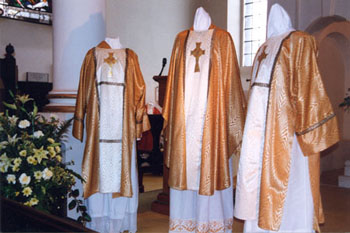
Another example:
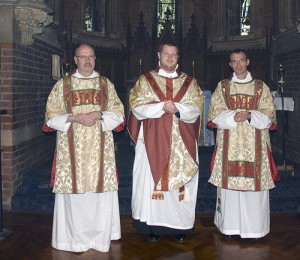
Which is which? Easy.
But some sets don’t distinguish, perhaps because pieces were lost or the makers, designers didn’t make a tunic, and the garments are identical. Some more modern sets may have just two dalmatics (both with two stripes)
In that case, as soon as the deacon puts on his garment he is putting on his dalmatic and when the subdeacon puts on his his is putting on his tunic… even though they are identical.
In this shot the vestments are the same, but clearly the guy on right is wearing a dalmatic by the fact that he is the deacon, and the guy on the left is wearing a tunic by the fact that he is subdeacon. It becomes a matter of pure coincidence that the garments are the same.
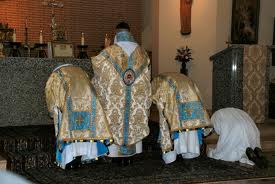
So too here. If this is a Solemn Mass with the 1962 Missal, one of these guys is wearing a tunic that looks like a dalmatic. If it Novus Ordo… well… if they are both deacons, then I guess they are both dalamtics.
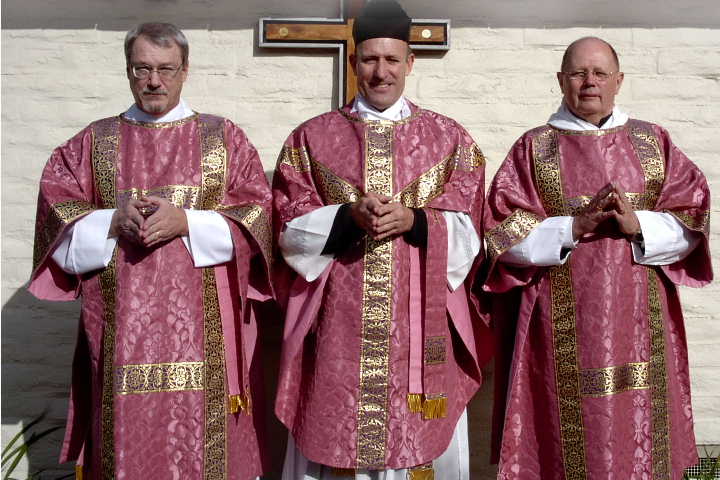
Here you can see which one is the deacon. He’s got more stuff on him.
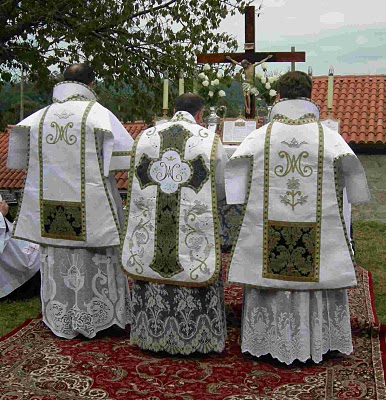
When a bishop puts on his pontifical vestments, the first one he puts on is the tunic, even though there isn’t any difference between it and the next one he puts on.
Preserved Killick would be able to explain this: “Which when he put’s it on, it’s a tunic, ain’t it, ya grass-combing lubber?”
Think of it this way. When Jack Aubrey, of the celebrated series, while still just a commander took command of a brig-rigged vessel, that vessel became a sloop, by the fact of his being in command.
Clear?
Anyway… the tunic was “suppressed” in 1969? Pah! Piffle, I say!
Let tunic abound. Where ever there be Solemn Masses and, therefore, the role of subdeacon, let that subdeacon wear his tunic with distinction and pride!
And as far as the question of the suppression of the subdeacon is concerned, sure, let’s all read together Paul VI’s Ministeria quaedam.
Having read that, I have to ask, when the Holy See gives permission to the Fraternity of St. Peter to ordain subdeacons… what happens? Are they subdeacons or aren’t they? If they are, then I think they should put on the tunic they were ordained in. If they aren’t subdeacons… what are they doing? Pretending to ordain? Would the Holy See sanction a pretend ordination? Unlikely. We have the use of the 1962 Missal. Someone has to fill the role of the subdeacon. When someone does that, he wears the tunic.
This isn’t hard.


































All good points…
Thanks for the defense of the tunicle…now we need to offer more support for the long term use of the maniple, even in the OF….nothing says we can’t use it….tunicles and maniples….and coffee…(should we cue the music?)
The subdeacon continued to exist in 1969. He still wore the tunic in the Novus Ordo. He was only abolished with Ministeria quaedam in 1973, and hence only in the 2nd edition of the Roman Missal did his function disappear or rather get distributed to others.
The instituted acolyte can be called a subdeacon at the discretion of the Conference of bishops, and he can wear the tunicle as can be seen in some locales.
What is the thinking behind having (near) identical vestments for a person who has received the sacrament of Holy Orders (deacon) and an office that is non-sacramental (subdeacon)?
Katherine,
I don’t have a proper answer on that one, but at least in the Latin Rite the subdeacon’s role seems to have evolved downwards from that of the deacon, rather than upwards from that of the acolyte. In the Roman Church, the subdiaconate comes with the obligation to recite the Divine Office and is considered an impediment to marriage. St. Thomas considers it to be a permanent consecration, like religious profession, even though according to the common teaching of the Church neither the subdiaconal ordination nor solemn profession confers an indelible character in the same way as the sacraments of Baptism, Confirmation and Order.
The Eastern Churches seem to have different rules on that one.
However, consider that the tunic was, in fact, a pretty standard item of clothing for a long time, that the chasuble was originally secular dress, and so forth… and maybe it doesn’t seem so odd anyway.
Oookaayy…. go to NewAdvent and look up ‘Vestments’, then scroll down to ‘History’. I can’t figure out how to use html.
but at least in the Latin Rite the subdeacon’s role seems to have evolved downwards from that of the deacon, rather than upwards from that of the acolyte.
I didn’t know that! Can you tell me more?
“What is the thinking behind having (near) identical vestments for a person who has received the sacrament of Holy Orders (deacon) and an office that is non-sacramental (subdeacon)?”
I doubt it was actually thought out, at all. It’s just a matter of a consequence that has arisen.
At any rate, the tunic worn by a non-ordained man acting as a subdeacon isn’t the only example of persons not in Holy Orders donning a vestment normally associated with clergy. Before the liturgical reforms, tonsured clerics serving in solemn pontifical liturgies could wear the cope in attendance upon the bishop: the miter-bearer, crozier-bearer, book-bearer, and bugia-bearer. Furthermore it was sometimes the case that the cross-bearer would wear a tunic, even though he did not have Holy Orders.
Secular monarchs, on the occasion of their sacring/coronations, wore sacredotal vestments. The British monarch is invested at his or her enthronement with vestments that make him or her appear quite priestly: the Colobium Sindonis (an alb, essentially), the Supertunica (tunic), the Armilla (stole), and the Pallium Regale (cope).
I’m sure plenty of other similar examples could be cited.
In the photo of the rose vestments, I’m guessing the guy on the left might be the deacon. He seems to be wearing a maniple while the guy on the right is not.
The subdeacon question is of particular relevence to men, like me, who are instituted acolytes. I often feel as though we are neither fish nor fowl when it comes to our role in the EF Mass (and the OF Mass for that matter).
As Fr. Z has stated before, Ministeria Quaedam, paragraph 4 states:
There is uncertainty, at best, as to whether the acolyte a subdeacon, or is merely a straw subdeacon, at an EF mass. I would also note that canon law states that the Instituted Acolyte is an Extraordinary Minister of the Eucharist.
I note that in some of the pictures, in addition to the one bar/two bar distinction, the tunicle is shorter than the dalmatic. Fortescue mentions this as well – and I confess a fondness for his little “one bar” icon for the subdeacon in his diagrams.
@jkm210 That picture is from All Saints Anglo-Catholic parish in San Diego. They use Rite 1 of the 1979 BCP. Both men are probably anglican deacons but the one without the maniple is an acting SubDeacon
A favorite O’Brian quote….
“God’s my life, if the Captain was to hear you carrying on in that reckless Jacobin, democratical line, why, I dare say he would turn you adrift on a three-inch plank, with both your ears nailed down to it, to learn you bashfulness.”
I’m not familiar with the piece of literature being quoted, here, but I nearly roared when I read the above. “To learn you bashfulness.” Love it.
For what it is worth, in the Dominican Rite, the outer vestment of deacons and subdeacons are supposed to be identical and both are called “dalmatics.” When in a Dominican Rite Mass there is a difference it is because the vestments are Roman ones or where purchased by someone who didn’t know that they should be the same in the Dominican Rite.
One final comment. As quoted:
“The functions heretofore assigned to the subdeacon are entrusted to the reader and the acolyte; … There is, however, no reason why the acolyte cannot be called a subdeacon …”
Since all the functions of the subdeacon have been assigned to the reader and acolyte, and I have never heard of an installed acolyte that was not also an installed reader, the “reader-acolyte” is functionally a subdeacon. So it makes sense that he can be so called. Ergo, I think most of the constant chattering about whether he is a “straw” subdeacon rather not in point. He has all the functions of a subdeacon, ergo he can do anything a subdeacon could/can do, including wear “subdeacon” vestments, incl. the maniple. IMHO
Hello!
For those interested, I have just posted an entry on my own blog on a related subject– that of the Instituted Ministries.
You can see the post here:
http://benedictus-dominus.blogspot.com/2011/01/instituted-lectors-and-acolytes.html
In it, I attempt to dispel the notion that the minor orders were supressed. As Fr. Z said– if that’s the case, then how can the FSSP be doing something like they are? Are they just superfluously doing it, even though they “don’t mean anything”?
(Sorry to use the space as “advertisement,” Fr.– I just figured, rather than re-hash everything I wrote there, it made more sense.)
In referring to my trusted Catholic Dictionary by Donald Attwater he says concerning the Latin Rite Subdeacon: “the lowest of the major orders, a sacramental of ecclesiastcal institution involving the obligation of perpetual celibacy and daily recitation of the Divine Office.” Here is my question: How is a Latin Rite Subdeacon in major orders?
Council of Trent, Session 23, Chapter II
“…[T]he subdeaconship is classed amongst the greater orders by the Fathers and sacred Councils, wherein also we very often read of the other inferior orders.”
The Council also, later, makes distinction between the minor orders (which may be conferred at the same time) and the subdiaconate and diaconate, both of which are referred to as ‘sacred orders’ in contrast to the minor orders (Ch XI ff).
It is the first part that interests me, because the Council Fathers neglect to give any references…
S.J.–
In my researching, it seems there is a lot of confusion over the nature of the subdeacon. Though I don’t have a copy of the rite of ordination (wish I did!), the dispute I was reading about was over whether there is a sacramental character is imparted on the recipient.
The fact that they take a vow of celibacy and the Office is what differentiates them from minor orders (and, also, presumably, why they get to wear a tunicle, rather than simply choir dress)… It might be easier to classify them in the nebulous region in between minor and major orders.
roamincatholic,
I tend to agree with you. Celibacy or marriage is required for the subdiaconate in the Byzantine Rite before ordination just as the other major orders of deacon and priest. In fact several Byzantine canons place the subdeacons with the other “sacred ministers of the mysteries” which positions them beyond those in minor orders, and is in agreement with the Latin Rite placing of them in major orders. There seems to be much confusion East and West as to where the subdeacons belong though today i.e. major or minor orders. I’ve come to your same conclusion that they are currently somewhere in between, which is annoyingly perplexing because I do not believe this can really exist except in my own mind, and not the historical mind of the Church.
I do not agree with Father Z. This is very hard.
Paul VI is clear in “MINISTERIA QUAEDAM”
1) the minor orders are now called ‘ministries’ since they do not in any way involve ordination.
2) the major order of subdeacon no longer exists. He says if you want to call an ‘acolyte’ a subdeacon, go ahead, but this office is merely a ‘ministry’ – it does not involve ordination.
3) ordination begins with the office of deacon.
Anyone called a subdeacon (really an acolyte) is a layman, not a cleric.
If Rome is now approving of the “ordination” of “subdeacons”, then is one of these “subdeacons” an ordained cleric (on account of the ordination ceremony), or not (on account of “Ministeria Quaedam”) ?
You have to choose between (1) Rome suppressing the order of subdeacon, clearly done by Paul VI…and (2) Rome approving the ordination of subdeacons by FSSP. Of course, that means you have to reject one of those two options as well, and potentially subject yourself to the charge of disobedience to Rome.
Muckemdanno–
Could you please just point out where in the document it says “since they do not in any way involve ordination”?? He actually doesn’t address what a “minor order” actually is and isn’t. He refers to them, and then moves on to get to his point.
What about the part of the document that says that, should any bishops conference or other body desire, they can retain the use of the minor orders? Paul VI is very clear– he says “universally” the ministries of lector and acolyte will be retained, but other ministries can be used as desired (with approval).
See– if he had suppressed the minor orders, he would have issued a statement like this:
“Though venerable in our tradition, and in an effort to adjust the liturgy to the needs of the times, we have seen it fit to no longer continue the ordination of clerics in to the minor orders. A superfluous action that imparts no actual character on to the person, we hereby suppress them. The ministries formerly known as minor orders will be taken on by a new form of minister, instituted by the local ordinary, known [coincidentally, of course] as Lector and Acolyte.”
As it is, there is only a change in the language used to describe the title of the office held, not a suppression and creation of something new. I think that you are reading in to the document when you say that Paul VI says that what takes place is not “ordination”… though, of course, when I say that, I in no way am equating them with priestly orders.
Since your foundations are shaky, I don’t think that I have to choose between your two options… in fact, as S.J. and I were discussing above, though ambiguous, there probably is a via media in this case. Perhaps the letter from Pope Benedict on S.P. 3 years on will offer some clarification.
Until then… I think it’s safe to say that what the FSSP, the Congregation of the Oratory, the ICRSS, etc, are all in the heart of the Church when they ordain someone to subdeacon… The definition of what that is, substantially, just needs to be clarified.
God bless!
Hmm… maybe I’m just here to find the charcoals in the barbecue are all white and cold, but it would seem that one might almost say that “tunicle” has shifted from the name of a kind of garment to an office that certain garments may fill. It’s particularly interesting that in this case the particular kind of garment has sometimes been the symbol of a particular office that certain persons may fill; but in this wise it has become like the word “angel”. When we talk of the Angel Gabriel we refer to the holy creature in the office of messenger to Mary announcing the Incarnation — but if naming the kind of creature he is, he should be more properly called a seraph… all though, I hear also St. Thomas argues that each created incorporeal spirit is a distinct species, so “Gabriel” is probably best.